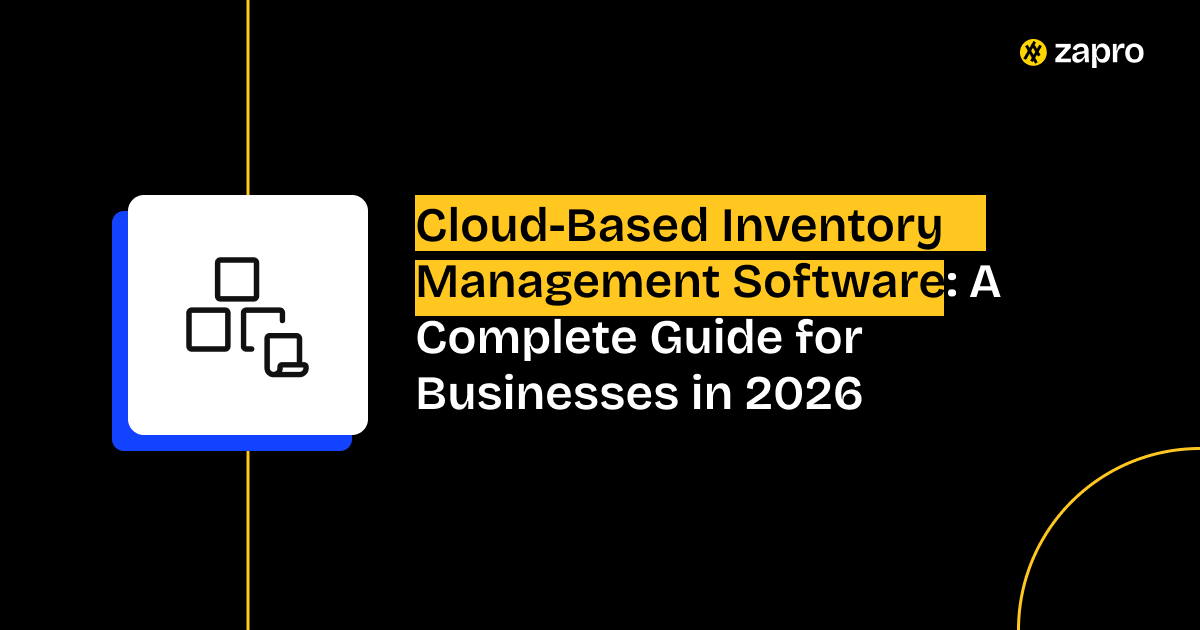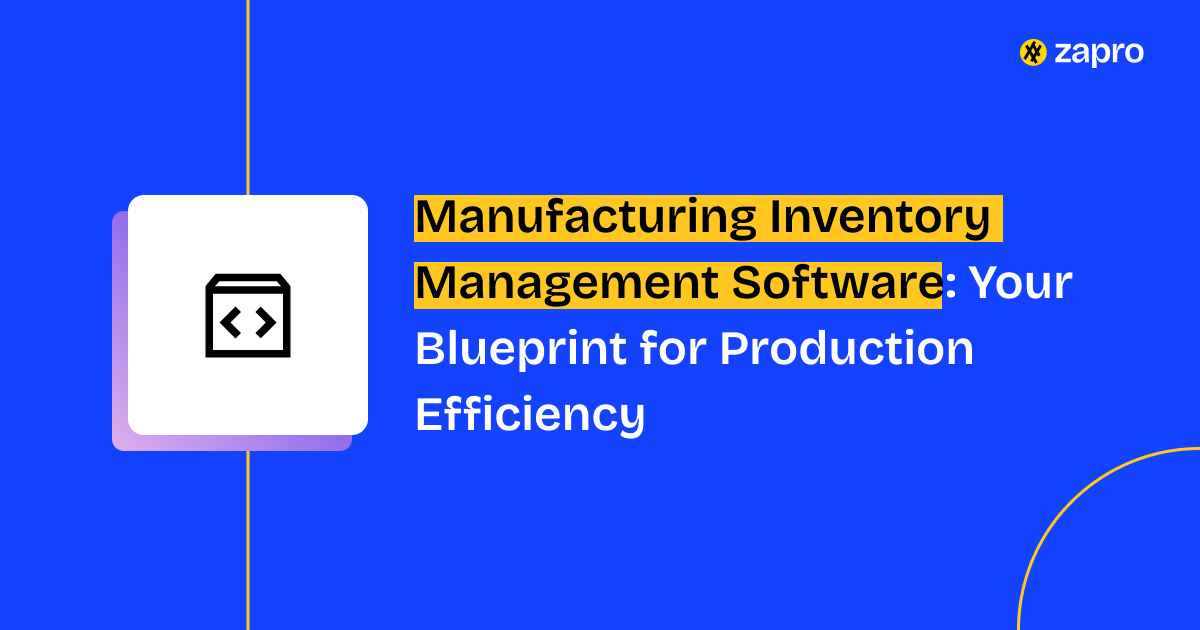Inventory control started with handwritten records and manual counts, suitable for simpler times but highly prone to errors. The arrival of spreadsheets in the 1980s brought more structure but still lacked real-time insights and automation.
As supply chains became more complex, these methods couldn’t keep up. Businesses began adopting systems like IMS and WMS, followed by cloud-based platforms that offered better visibility, scalability, and control.
Today, we’re seeing a shift toward smart, connected technologies that go beyond tracking to optimize every aspect of inventory. But what exactly are these technologies?
Let’s explore the core tools driving modern inventory control.
What are the core technologies driving modern inventory control?
Modern inventory control is powered by a suite of advanced technologies that work together to improve visibility, speed, and accuracy.
Here’s a breakdown of the key tools transforming how businesses manage stock:
- Inventory Management Software (IMS/WMS): These platforms serve as the digital backbone of inventory operations—centralizing data, enabling real-time tracking, and streamlining order and stock movements.
- Automation (Robotics & AS/RS): Robotic systems and automated storage solutions reduce manual effort, speed up picking and packing, and improve accuracy in high-volume environments.
IoT & RFID: Internet-connected sensors and RFID tags provide real-time updates on inventory location, temperature, and handling conditions—critical for industries like pharma and food. - AI & Machine Learning: AI algorithms enable predictive forecasting, detect anomalies, and help optimize stock levels based on demand patterns and historical data.
- Data Analytics & Business Intelligence (BI): These tools turn raw data into actionable insights—revealing trends, inefficiencies, and opportunities for optimization across the supply chain.
- Cloud Computing: Cloud-based systems offer scalability, remote access, and lower infrastructure costs, making them ideal for growing and distributed businesses.

According to a recent survey by MHI, 89% of supply chain professionals plan to invest in robotics and automation within the next five years, signaling how central these technologies are becoming.
Next up, we’ll look at the tangible benefits companies like yours can unlock by actually adopting these technologies.
Benefits of technology-driven inventory control
Adopting modern inventory technology brings more than just convenience—it delivers measurable business value. Here are the key advantages companies gain:
Optimized stock levels: Intelligent forecasting helps prevent overstocking and stockouts, ensuring better cash flow and customer satisfaction.
Improved accuracy: Automation and real-time tracking significantly reduce human error and inventory discrepancies.
- Enhanced efficiency: Automated workflows speed up routine tasks like picking, packing, and restocking, freeing up time for higher-value work.
- Reduced costs: Lower holding costs, less waste, and reduced manual labor translate into major savings over time.
- Greater visibility: Cloud-based platforms and IoT sensors provide a clear, real-time view of inventory across locations.
- Increased agility and resilience: With predictive insights and real-time data, businesses can adapt faster to supply chain disruptions and shifting demand.
Next, let’s look at the challenges businesses face when implementing these technologies and how to overcome them.
Challenges in implementing inventory technology
While the benefits of inventory technology are clear, implementation isn’t always smooth. Many organizations face roadblocks that can slow or complicate adoption:
- High upfront investment: Advanced systems and automation tools often require significant capital outlay, especially for smaller businesses.
- Integration complexities: Aligning new systems with existing ERP, CRM, or legacy tools can lead to delays and technical challenges.
- Data quality issues: Technology is only as good as the data it uses. Inaccurate, outdated, or poor inventory data can undermine the effectiveness of new systems.
- Resistance to change: Employees accustomed to manual processes may be hesitant to embrace new workflows or tools, requiring change management.
- Talent gaps: Managing and maintaining tech-driven systems often calls for specialized skills that may be lacking internally.
- Cybersecurity concerns: As inventory systems become more connected, they also become more vulnerable to cyber threats if not properly secured.
Despite these challenges, businesses that plan carefully and invest in the right partners can overcome barriers and build more robust inventory operations.
Future trends in inventory technology (2025 and beyond)
Inventory control is evolving fast, thanks to ongoing digital transformation. It’s no longer just about tracking stock—technology is now enabling faster, smarter, and more proactive inventory decisions.
So we searched across the internet and have listed five key trends shaping the future:
1. Digital twins
These are virtual models of physical warehouses that help simulate layouts, test process changes, and optimize operations without disrupting daily activities.
2. Hyper-automation
By combining AI, robotics, and RPA, companies are automating entire workflows—reducing manual tasks, speeding up operations, and minimizing errors.
3. Drone-based inventory counting
Drones equipped with scanners and cameras are making inventory checks faster and less labor-intensive, especially in large or high-rack warehouses.
4. Blockchain for traceability
Blockchain enables secure and transparent tracking of products across the supply chain, improving authenticity, compliance, and accountability.
5. Prescriptive analytics
These tools don’t just forecast demand—they recommend actions in real time, such as adjusting reorder points or redistributing stock to prevent shortages or overstocking.
Smart warehouses powered by IoT, AI, and real-time analytics are no longer a future concept. They’re quickly becoming the new normal.
Next, let’s look at how Zapro.ai helps businesses tap into these innovations today.
How Zapro.ai leverages technology for superior inventory control
Zapro.ai combines the latest in automation, intelligence, and user-centric design to help businesses modernize their inventory processes without complexity.
Here’s how Zapro brings innovation to life:
- Real-time tracking: Gain complete visibility into inventory movement across locations, with instant updates on quantities, orders, and SKUs.
- Predictive forecasting: AI-driven demand planning helps reduce stockouts, overstocking, and emergency orders—improving efficiency and customer satisfaction.
- Automation-ready workflows: Zapro enables rule-based automation for reordering, replenishment, and stock transfers, reducing manual effort and response times.
- Data-backed decision-making: Built-in analytics dashboards offer insights into performance, trends, and inefficiencies—so teams can act faster and smarter.
Whether you’re managing a single warehouse or a global supply chain, Zapro empowers teams with the tools they need to stay agile, accurate, and cost-efficient.
Case study: Zolo cuts 28% in inventory overhead using Zapro.ai
Company: Zolo
Industry: Consumer Electronics Distribution
Challenge: Zolo faced ongoing issues with stock imbalances across its regional warehouses—resulting in overstocking in some locations, frequent stockouts in others, and rising holding costs.
Solution: Zolo implemented Zapro.ai’s inventory control suite, activating real-time visibility, AI-driven demand forecasting, and automated replenishment rules across all five distribution centers.
Impact:
- 28% reduction in overall inventory overhead
- 40% boost in order fulfillment accuracy
- Stockouts dropped by 65% in just three months
- Improved team coordination with centralized, real-time inventory data
Result: With Zapro.ai, Zolo transformed its inventory operations from reactive to predictive. Zapro enabled Zolo to boost efficiency, cut down on wasteful expenditure, and enabled faster, smarter decision-making.
Calculating the ROI of investing in inventory technology with Zapro.ai
Investing in inventory technology isn’t just about modernization but about unlocking operational and financial gains.
| Feature | Zapro.ai | Legacy Tools |
Unified buying & selling portal | ✅ Yes | ❌ Buyer-side only |
Embedded Amazon Business integration | ✅ Deep native access | ⚠ Limited PunchOut support |
| Full AP + AR automation | ✅ End-to-end | ❌ Needs 3rd party tools |
| Supplier collaboration | ✅ Multi-customer portal | ⚠ Basic or siloed |
| Setup speed & ease of use | ✅ Consumer-grade UI | ❌ Lengthy, complex deployments |
| Built-in AI/ML across workflows | ✅ Everywhere | ⚠ Limited to analytics |
Here’s where businesses typically see returns with Zapro:
- Reduced carrying costs: Smarter stock levels reduce the capital tied up in unsold inventory.
- Minimized stockouts: Better forecasting leads to fewer lost sales and happier customers.
- Lower labor expenses: Automation reduces manual processes, freeing up teams for high-impact work.
- Improved fulfillment rates: Real-time data helps avoid delays and errors in order processing.
- Scalable savings: Cloud-based deployment and modular tools mean you pay only for what you need.
Want to estimate your potential ROI?
Use the Zapro ROI Calculator to see what better inventory control could save you.
Next up: A quick checklist to help you evaluate the right inventory tech partner.
How to Choose the right inventory technology solution?
Before investing in inventory software, here’s a checklist of what to evaluate:
- Feature depth: Does it support real-time tracking, forecasting, and automation?
- Ease of integration: Can it work with your ERP, accounting, or procurement systems?
- Scalability: Will it grow with your business and adapt to multiple warehouses or locations?
- User experience: Is the interface intuitive for both warehouse staff and leadership?
- Security & compliance: Does it offer strong data protection, especially for cloud deployments?
- Support & onboarding: Are implementation and training resources available?
Evaluating vendors against these criteria ensures you’re choosing a future-proof solution not just a short-term fix.
Why Zapro.ai is the future-ready choice for inventory control
Zapro.ai isn’t just another inventory tool—it’s a modern, AI-native platform built to solve the shortcomings of traditional systems.
From unified workflows to intelligent automation, Zapro reimagines inventory management as a connected, intuitive, and insight-driven experience.
Here’s how Zapro stacks up against legacy tools:
What makes Zapro different?
- Unified, not fragmented: One platform for buying, selling, tracking, and collaborating.
- End-to-end automation: From order to reconciliation, no third-party patchwork needed.
- Built-in intelligence: AI/ML is embedded across workflows, not an afterthought.
- Quick to adopt: Consumer-grade UI means teams can get started in days, not months.
With Zapro.ai, inventory control isn’t just digitized, it’s transformed into a proactive, value-generating engine.
Ready to take control of your inventory?
Whether you’re looking to eliminate stockouts, automate your workflows, or gain real-time visibility across locations—Zapro.ai gives you the technology edge you need.
Start your transformation today.
Request a Demo or Explore Zapro’s Inventory Tools to see how future-ready inventory control looks in action.
Improve your supplier relationship in just a click!

Frequently asked questions (FAQs)
1. How does AI specifically help with inventory forecasting?
AI improves forecasting accuracy by analyzing historical sales, seasonality, market trends, and real-time demand signals. Instead of relying on static reorder points, AI models dynamically adjust predictions, helping businesses prevent overstocking or stockouts.
2. What is the difference between WMS and IMS?
A Warehouse Management System (WMS) focuses on optimizing warehouse operations, like picking, packing, and space utilization. An Inventory Management System (IMS) tracks inventory levels, locations, and movement across warehouses, retail, or supply chain nodes. They often work together but serve different scopes.
3. Can RFID technology replace manual inventory counts entirely?
In many environments, yes. RFID can automate real-time tracking and reduce human error, but full replacement depends on infrastructure, cost, and item type. Some manual checks may still be needed for damaged goods or exceptions.
4. How does cloud computing impact inventory management accessibility?
Cloud-based systems allow inventory data to be accessed anytime, from any device, supporting remote teams, multi-location visibility, and real-time decision-making. It also enables easier integration with other tools like ERP or e-commerce platforms.
5. What are the cybersecurity risks in connected inventory systems?
Risks include unauthorized access, data breaches, and ransomware. Securing APIs, enforcing user-level permissions, and choosing vendors with robust encryption and compliance protocols are key to mitigating these threats.
6. How can small businesses afford advanced inventory technology?
Modern solutions like Zapro.ai offer scalable pricing, cloud-based access (no heavy infrastructure), and modular features, making it accessible for small and growing businesses. The ROI from reduced losses and improved efficiency often offsets the upfront investment.
Don’t miss our weekly updates
We’ll email you 1-3 times per week—and never share your information.

 Healthcare
Healthcare Financial Services
Financial Services Technology
Technology Venture Capitalist
Venture Capitalist Chief Procurement Officer
Chief Procurement Officer Chief Financial Officer
Chief Financial Officer




